Last year I was fortunate to meet a couple who used the framework to help them live in a complex uncertain world. (https://www.scrum.org/resources/blog/using-scrum-help-attention-deficit-hyperactivity-disorder-adhd-part-two) . Since then I've been approached by other people who have been inspired by them. So "thank you Sally & Francis" for doing this and thank you to those who have shared their lives and struggles with me.
I'd like to share another story with you... Thank you Paul and Charlie for sharing your story. It moved me and left me with huge smile on my face.
Below is the word for word post Paul sent to me. Enjoy....
Introducing Charlie…
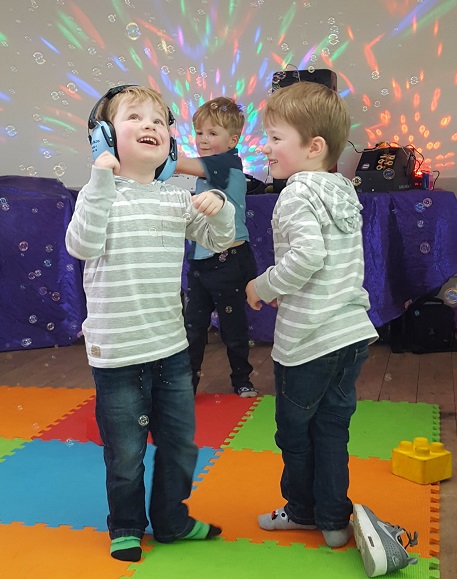
Charlie is 6 years old, a twin and one of strongest and most inspirational people I have ever known.
To understand his story and how Scrum supported him, I’ll start at a great and obvious place, the very beginning.
I met my beautiful wife 15 years ago at our place of employment. Her beautiful green eyes stole the heart of a man who enjoyed the single and social life. Her smile turned my life upside down and I was suddenly hit with the most horrific illness I have ever felt. Sickness, lack of concentration, unable to eat or drink, and no interest in anything going on in the world.
I soon found that this ill feeling was love in it’s most powerful state…it was love at first sight.
We instantly built a home, a future and knew that we were destined to share our lives together.
After taking the sensible step to secure a home and marry (I’m old fashioned that way) we were ready for the next step, we were ready for our family.
After 3 years of trying and no sign of our family, we sought medical support and endured a very long 3 year journey of IVF.
During this time we had two attempts! Two babies ready to join our world and make our dreams come true. Sadly however, it wasn’t their time to stay and we lost them both in the first few weeks.
I recall the moment we stood outside one summer day, we set alight two lanterns, said goodbye to our babies and told them we hoped one day they would have another chance to come back to this world and be loved in the way we would have loved them. It was at that moment we knew our chance and dream was gone for good, or so we thought.
Now this could lead to a whole other story so I’ll aim to keep what happened next brief.
Our dream didn’t just come true… Those babies we said goodbye to — those lanterns we set free that drifted up into the sky — decided that they did want another chance and they did want that chance to be loved, and they chose to be loved by us. One fine morning in May, my wife woke me with the news that she had done a test and was pregnant, but not just pregnant, a scan later confirmed it was identical twins.
At that very moment in time, the world stood still and the sun was shining brighter than it had ever shone in my life.
Now as I say, the finer details of this story are for another time but suffice to say, the sun went dark and 17 weeks into our pregnancy we were hit with the devastating news that our twins had a condition called TTTS (Twin to Twin Transfusion Syndrome).
There really isn’t enough awareness of TTTS and for that very reason I recall the time we were told, my wife was in pieces and I was sat wondering why we had been taken into a private room and why my wife was so upset when we were having 2 beautiful babies?
After leaving the room my wife explained. The chances of our boys surviving were slim to none, and if either of them did, it was likely they would live with life changing challenges.
Someone was looking down on us…
A few weeks later we were heading down to Birmingham to the care of Professor Mark Kilby, the man who was to perform delicate and miraculous laser surgery on the placenta and aim to save our beautiful boys.
The procedure was both shocking, scary, heart wrenching and amazing to watch as this man carefully burst joining blood vessels in the placenta in the hope of providing both boys with a balanced blood flow.
After the procedure, we waited several hours (which felt like a lifetime) to have the scan that would tell us if we still had two little hearts beating inside. It was an agonising wait and one that should have been full of joy.
We were later told that both hearts were beating but we would need weekly scans to check they were still alive. You can only imagine how the drive home felt. An agonising silence that continued weekly. Despite every positive scan, we lived in fear of what the next may bring.
In the end, we hit week 34 and through C-section our boys were born. Today we have two bright, beautiful, loving boys named Charlie and Evan.
Both have their challenges but they are here and they make the world a better place every single day.
Meet Charlie…
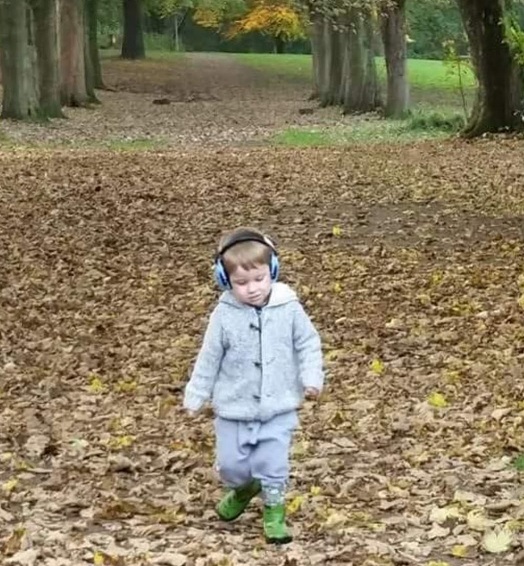
Charlie is diagnosed with Asperger’s and sees the world in the most beautiful and scariest of ways.
We knew from a very early age that Charlie was on the Autistic Spectrum as his behaviour, his interests and his mannerisms were very different to that of his brother’s and other children his age.
For anyone who has been through the same, getting a diagnosis at such a young age and getting the support from the child’s school is notoriously difficult. However, we were fortunate to have our son in a great school that noticed all the key traits early and pointed us in the direction of support. Support that led me to see an opportunity to help even more.
Instead of sharing with you what Google’s stated traits of Asperger’s are, let me tell you about Charlie.
Charlie doesn’t just struggle with change, it turns his world upside down.
If you brush his teeth before getting him dressed, he would fight, scream, cry, push you away and become inconsolable with emotion.
If we took a different turn in the car to our normal route due to roadworks, it would take hours to calm him down and put him at ease, sometimes days! This would then lead to immense anxiety on subsequent days, with us struggling to get Charlie to even consider going near the car again.
At the age of 4, Charlie could tell you every single detail about the Flying Scotsman Train. Who built it, when it was built, it’s speed, every fine detail you could and couldn’t imagine.
I recall buying him a Hornby replica set for Christmas. For weeks I could never understand why Charlie was always so cross with it. Whenever I built it up ready for him to play with, he would crouch down, look at it, knock the train over and tell me it was wrong.
Charlie wasn’t particularly articulate at that age and speech delay is common with children on the Autistic Spectrum so trying to get to the bottom of the problem was very difficult and frustrating for me and for my little Bear (he’s my Charlie Bear so I’ll probably refer to him by this quite a lot).
Now Charlie may not have been great at putting into words what was bothering him, but one thing is for sure, Charlie knows when something is wrong and one way or another he would let you know.
Well I was blown away! One day, I put the track together and Charlie sat and played nicely with it. I was baffled? Why?
I sat and studied the train, the box, online pictures, you name it. I couldn’t for the life of me figure out why it was OK this time around. But what I did notice was that Charlie was staring at the 5 digit numbers on the end of each carriage. Now these numbers weren’t in any kind of sequence that you might expect e.g. 12345 on carriage 1 and 23456 on carriage 2. No, they were random numbers, apart from one notable point. If put in order, the sequence of numbers on each carriage was greater than the previous e.g. 25067 - 31058.
Even on the box these weren’t in order! But to Charlie it was a must and unless they were ordered correctly and in numerical value Charlie couldn’t settle or play with it.
I think by now you get the idea; Charlie is a sponge for information and order. Process and structure means everything to him!
As time went on and whilst we were waiting on professional support, this need for order and structure had led to many distressing situations.
He would run out into a road if a car horn was beeped or a bus gave out those air pressure noises as it passed.
If he ever sees anyone in a costume or a mask, then we have days or panic, screaming, nightmares, refusal to eat and zero eye contact with anyone, even those he knew would keep him safe.
He will stim (self-stimulatory behaviour) for comfort, for example rocking back and forth and rubbing his hands on the fabric of the sofa. He will go on all fours and will rub his forehead on the carpet over and over again to sooth and calm himself.
Yes it is fair to say that my Bear sees the world different to us, he needs calm, order, structure without deviation, he needs patience and he has to be in full control of everything, which sadly, isn’t always possible in this hectic world we live in.
And so time went on… We had support from Neurology, Occupational Therapy, Psychotherapy, with appointment after appointment. Supportive techniques and coping strategies aplenty, some helping, others not.
Until one day at a school meeting, we met with one of the teachers who had just finished an Autism training course. She suggested a good way to help Charlie reduce his anxiety at school might be to introduce a visual aid. A simple board that would have pictures on showing Charlie what he could expect to happen throughout the day. Highlighting each class, lunch and break, assembly and so on. It would be something Charlie could go to as often as needed and even help move cards along as he finished a particular element, giving him a level of control and of course, the structure he needed.
Now around this time I had just embarked on a career change after over 20 years in leadership and Operational Management roles and moved into the role of a Scrum Master. I had just completed my CSM (Certified Scrum Master) and started with an amazing team in Sky Leeds Dock. My knowledge of course was limited but I had a solid enough understanding to start my journey and new career.
So back to our meeting!
Here I was, a young (in the career sense), fresh and enthusiastic Scrum Master, sat listening to this teacher talking about a visual board, cards that can be moved when in progress or done, transparency of the board at all times. Well, you can only imagine the sparks going off in my mind, firing about ideas and creative thoughts.
Perhaps I could use Scrum to help my little bear??
The problem was that, when I sat back and thought about what I/we were wanting to achieve here, I also started to develop concerns around the approach school was taking. The idea of the board was great, this would give my boy a clear view of what his day looked like and give him a feeling of control around that, but I started to fear that this perhaps wasn’t such a great idea. My concern was that we were giving Charlie a false view of the world. As I said earlier, this is a chaotic world, things don’t always go to plan and if we start to give him that impression, surely this could only make matters worse?
I expressed my positive feedback around the idea and my concerns however the teachers were happy with their approach and wanted to proceed. As much as I wanted to challenge, at this stage I didn’t really have any other suggestions to put forward, so apprehensively we agreed and I decided to mirror the approach at home for consistency.
To start with we had a simple board:
To Do.
Doing.
Done.
We created fun, eye catching laminate pictures of each daily task such as having breakfast, brushing teeth, getting dressed and so on and we would spend 5 minutes every morning taking Charlie through what his day looked like and he would move the cards every time he started or completed a task.
It was working well! We instantly noticed that Charlie was asking less questions about his day (this was always a clear sign he was anxious) and he very quickly adopted the board and its updates as part of his routine. Feedback from school was also very positive and so we were very happy with how things were progressing.
That was until it happened…
It was a day like most, Charlie updated his board at home and followed structure to a tee. My wife put him in the car with his brother and headed out to school. Upon the bell ringing and the doors opening up, my wife was met by a strange face. Charlie’s teacher had been taken ill and there was a stand-in teacher for the day. Charlie’s face went a fearsome shade of white, his pupils wide and his hands instantly went over his ears, his head down and he locked down.
Charlie would not go into school. Things had changed and weren’t as per structure and as a result of this, he fell into a meltdown that took the best part of 3 hours to settle, only then did we manage to get him into reception and talking to family faces, but he had no plans to go to his class at all that day.
This was exactly what I had been worried about, I knew in my heart that the approach we were taking was flawed; yes, it had been working, but I knew the instant there had to be change of routine, it would all go wrong! And my worry now was that his faith in his board would be damaged beyond repair!
I needed a new approach.
Before I ironed out my plan, I sat with my wife and we discussed the key things we needed to consider and implement, and of course how we would get Charlie’s buy-in to using a visual aid again. By this point he had refused to look at it again so we had our work cut out for us.
I’d explained to my wife the cultural change our Agile Lead was implementing at work around “Cycle Goals”. I won’t go into the debate around cycle goals vs. committed metrics but that aside, having an end goal may be one great way to get Charlie back on board.
We also discussed how to prepare Charlie for unforeseen change and how to do so in a subtle, gentle way that either still achieves the goal, or complemented the goal further. Another point considered was how we would increment the approach, how would we increase that level of change and ensure that Charlie still felt in control of it? And finally, I wanted a way to not only let Charlie self-validate and reflect, I wanted a way in which we could collectively talk about what was going well, what could improve and how it could improve. This way Charlie didn’t just feel proud of his own achievement, but knew that others were proud of him too, or as the case may sometimes be, letting him know when things haven’t been done as expected.
And so we had it! I set to work creating our new visual board, we had the plan for our cycle goals, Daily Stand-Up, Sprint Review and Retrospective. I even had a cunning plan to introduce scope creep (yes I said it :O) ).
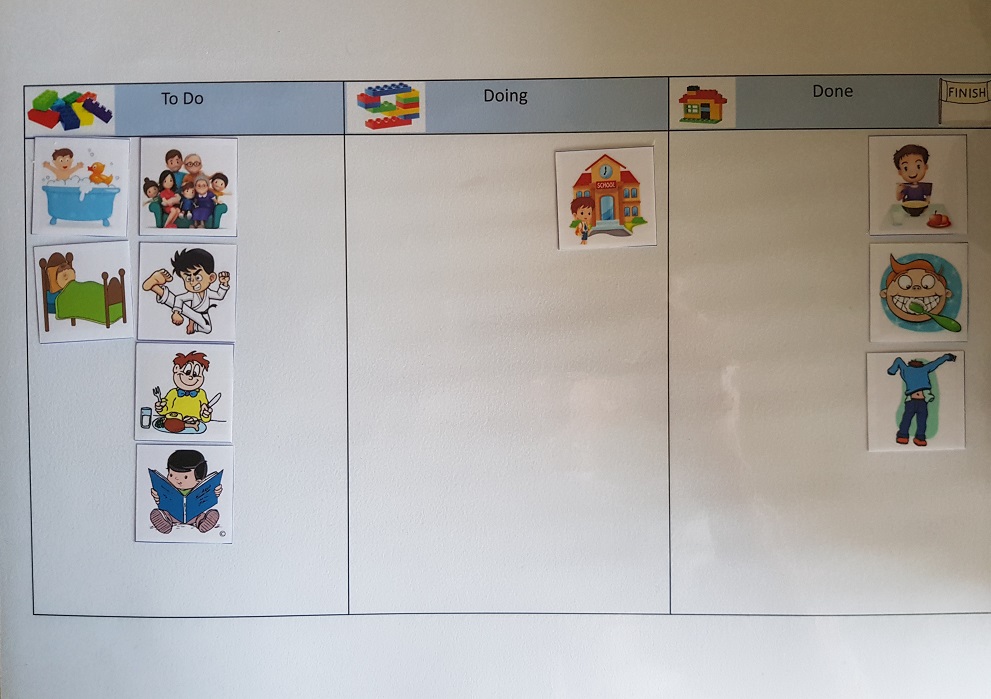
Charlie’s new cards were produced! Initially I spent a godly amount of my time creating templates that would last us weeks, perhaps even months. I became an expert at laminating!
The new cards would: as before, highlight the activities that Charlie needed to complete each day and as before, he would move them across to Doing and Done respectively, however this time we had a cycle goal.
You will recall me talking about Charlies obsession with certain subjects, well these were vast to say the least, ranging from: London landmarks, sports cars, RAF jets, world landmarks, train maps and more (yes, he’s only 5 too). And so the back of each card would now form a completed image of any of of the aforementioned topics. Charlie knew what the end image was, so we had instant buy-in for him to complete the picture as he was excited to see the finished product.
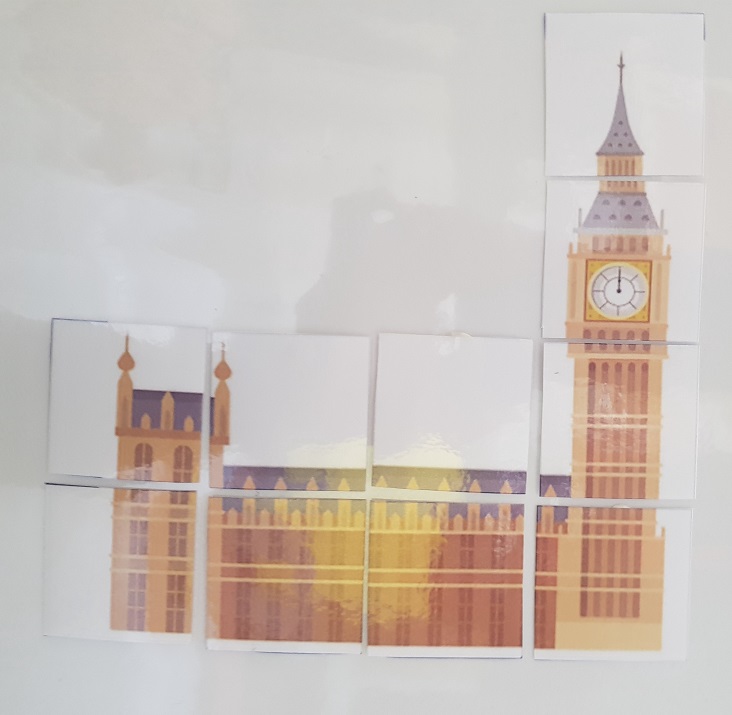
Every morning we would go to the board, I would pitch the cycle goal and Charlie would look at what his tasks for the day were, things were going well and were set to get even better!
A week into this approach, we sat with Charlie at the kitchen table for our retrospective and looked at all the images he had built over the week. We asked him if he enjoyed it and we even made this a fun opportunity to do something creative by sticking all the images onto one big sheet to put on his bedroom wall.
By this stage we clearly had buy-in with the approach and Charlie had confidence in the board again. We talked about the things he liked about the board and approach and anything he didn’t (his only feedback being that one of the pictures I had used that utilised clip art wasn’t right because Big Ben currently has scaffolding around it during its repairs and my picture didn’t — I considered myself told off!!)
As Charlie was very happy, we took the bold move to talk about adding a new card to each “cycle”, the card being a question mark. This card would be something, anything, that could happen during the day that we don’t yet know about. To put him at ease, we gave the example and ran with the idea of the first time being, to take him to the shop to get some sweets, or have some game time on the Nintendo Wii. All things that were rewarding and would reduce his anxiety to the unknown, but were by all intents and purposes, still the unknown.
I decided I would put my now perfected laminating skills to further use by making this new question mark card a compliment to the image we would create, for example; if we created the London Eye, the new image would be a London Cab or Bus to sit along side it. All this added to creating the feeling that change, albeit not always rewarding, wasn’t always a bad thing. Granted, the reality of the world is that sometimes it may well be, but for now, we had found a way to introduce the unknown, introduce change and actually help Charlie embrace it.
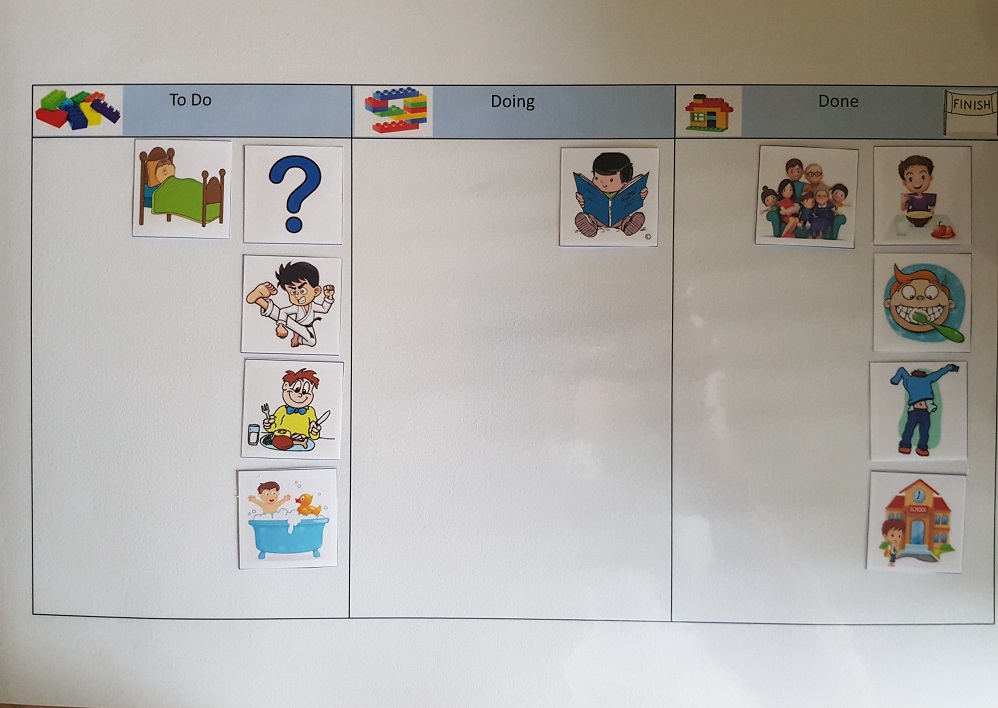
Inspect and Adapt
I have to admit, as time went on I really started to struggle with the volume of laminating and creating pictures/images for Charlie to build at the end of each day so I was conscious that we needed to grow and adapt this approach as time went on, plus we needed to consider that Charlie may also start to get bored of the approach which was very likely. Before that however, we needed to make this embrace of change even more challenging. So our next iteration was to introduce Charlie to the idea that if we didn’t do things in the same order every morning or day, the end results would still be the same.
So with that, we had another Retro, we discussed what had been going well, what hadn’t and set the action of shaking up the order in which we did some things each day. For example, having breakfast in his PJ’s instead of getting dressed for school first. On an evening we would have a bath before doing any reading (homework). All small changes, but they introduced something very special to Charlie, they showed him that the unknown, or even doing things in a different order, still led to a sense of completion at the end.
During this time Charlie was obviously growing up, there were certain things you can expect from a 6 year old that started to crop up, for example, not washing his hands after he had been to the loo or not putting his plate in the dishwasher because “it was mummy or daddy’s job”. For this reason, I had already started to think about my next iteration of our approach.
The most shocking of surprises
Now something very special happened one day. We were driving to see Grandma after school and as we approached the road that led up to her house, it had been closed down due to a burst water pipe. The fear that grabbed my wife and me as we had to pass the road and aim to take the next turn was chilling to say the least. The last time something of this nature happened, we had almost 4 hours of trying to calm Charlie down. However this time, it was different. Charlie looked up and said “Where are we going?”
I replied, “we are going to Grandma’s but that road is closed for some people to fix it so we just need to go another way”. You can imagine our surprise when Charlie just said “OK” and continued to look out of the window.
My wife and I almost cried! I can almost feel that same shivering, emotional flood of pride as I type this. My little Bear had been faced with an unexpected change and took it completely in his stride. Don’t get me wrong, this wasn’t the case for everything but in most part, he was adapting to small changes very well indeed and these were helping to dilute the impact bigger changes had on him. So overall, we were very pleased indeed.
Now let me go back to the point around a 6 year old’s habits and behaviours!
Although Charlie may demand structure, routine and order, it is very much on his terms. As such, putting toys away, putting dishes in the dishwasher, eating all his tea and washing his hands after the loo were very much something he cared little for. For this reason, I needed to introduce some testing strategies before any cards could be released; this way, we too had an element of control in our home. And so we did just that!
We had another retro and we talked about how well Bear had been doing with tackling things in a different order, the volume of unexpected changes to the daily routine that had happened, how well he was coping with them and how far he had come over the past few months. As with any Retro however, we also spoke about what hadn’t gone so well. With some reluctance, Charlie accepted that from now on, we would be adding in a new column on his board Check (which was nicely highlighted with a smiley and sad face).
Charlie now knew that before he could achieve his goal, Mummy and Daddy had to check everything had been done properly.
Let me review for a moment how far we had come and what we had done!
- We had reintroduced a visual aid which now resulted in an end of day goal.
- We introduced an unknown card that taught Charlie that despite not knowing what it is, it will still help him complete his goal and in some cases, reward or compliment his goal.
- We had found a way to change and shake up the order of delivery with Charlie learning that regardless of this, his goal could still be achieved.
- We had introduced a time to creatively discuss how things were going and introduce actions to make things better.
- We introduced a daily walk of the board as well as gently touching on how Charlie felt about any of the tweaks that may happen that day.
- We had introduced a new column and a way to Check that any cards completed were actually meeting an agreed definition of Done.
Our little boy was adapting day in day out to change and following an albeit adapted and diluted version of Scrum!
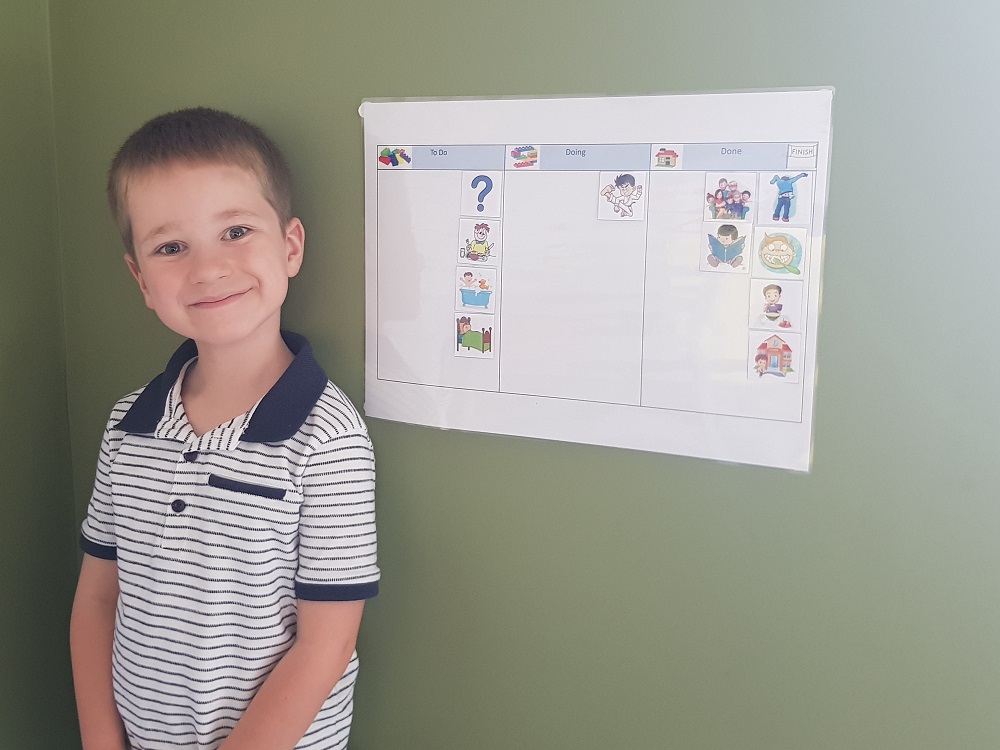
So don’t get me wrong, this story isn’t about giving an in-depth knowledge of Scrum and it certainly isn’t about me showcasing my knowledge of Scrum (I’m still very early in my journey to even attempt that). But what this story is, is an insight into the power of Scrum and how it can be used in so many walks of life.
One of my colleagues wrote an article last year that was published in Scrum.org which was about how she and her husband had utilised Scrum to support ADHD. I highly recommend you give this a read. See below:
When I think of Scrum and what I do every day at work, I instantly think of the Scrum Values. My manager taught me an easy way to remember these during my interview: “FORCC” (or fork as I recall it).
With that, I look back and think about our little boy and how far he has come over the past year and a half.
- Were he, my wife and I Focused on our respective Goals, daily and overall? Absolutely!
- Were we Open about how we were going to challenge him and talk frequently about how he was feeling about these changes? Every single day!
- Did we Respect him and work with his needs, at his pace and with his personal motivators and drivers? Without questions!
- Was our little boy Courageous? Well I’m sure the pride oozing out of the tone in this story answers that one :O)
- Were we all Committed to seeing this through and committed to supporting one another at every stage? You bet!
We have come a long way since all this began, I exhausted my ideas for pictures very early on and moved to simply telling Charlie what treat he could have at the end of each day if all the cards moved across the board, such as a walk to the park or some fun family game time or activity. We introduced more question marks and even started to remove some of the cards to really shake things up.
We have come so far, we have even started to span the approach out and remove the granular breakdown of daily tasks like getting dressed and having breakfast. Charlie just accepts that these happen and will do so in any order that suits that day. Instead, we now have a weekly board with some of the bigger events on, such as going to the cinema, bowling, tidying his room, or reading his book and practising for his spelling test. All of which Charlie has embraced incredibly well.
Don’t get me wrong, Charlie is by no means anxiety free and by no means fully adapted to change. He still has moments where something happens that locks him down, only time will help with this! But for now, he is a boy that can play with his friends, accept that he won’t always win, accept that his friends may do things differently to him and accept that sometimes, things happen that he won’t always like.
He is also a boy who I suspect will work very well in an Agile environment one day :)
Thank you for reading my story and sharing in Charlie’s journey.
Paul's original post can be found here - https://medium.com/@staffordpaul77/aspergers-and-scrum-b604bfc00c7e
